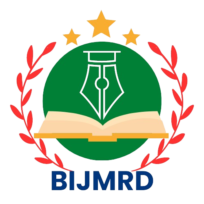Author: Prafull Ranjan Mishra & Dr. Koomkoom Khawas
DOI Link: https://doi.org/10.70798/Bijmrd/03060028
Abstract: The present study investigated the pyrolytic conversion of agricultural wastes such as rice husk, sugarcane bagasse, and corn stover to produce high-energy bio-oil, biochar, and syngas under optimized thermal conditions. Agricultural residues were thermally decomposed in a fixed-bed reactor at temperatures ranging from 400 °C to 550 °C in an inert nitrogen atmosphere. Among the tested biomasses, sugarcane bagasse yielded the highest bio-oil at 41.8%, while a blended feedstock of rice husk and bagasse (1:1 w/w) showed a synergistic enhancement, producing up to 42.6% bio-oil. Proximate, ultimate, and thermogravimetric analyses confirmed the low ash and high volatile content of the selected residues, making them suitable for thermochemical valorization. GC-MS analysis of the bio-oil identified key functional groups such as phenols, ketones, and furans, indicating its suitability for biofuel applications. The resultant biochar possessed a high carbon content and surface area, suitable for soil enrichment and adsorption applications. This research has highlighted the potential of agricultural waste pyrolysis as a sustainable energy recovery pathway that also mitigates open-field residue burning. The findings contributed to advancing circular bioeconomy goals by turning waste into valuable energy carriers.
Keywords: Agricultural waste, Pyrolysis, Bio-oil, Sugarcane bagasse, Renewable energy, Biochar.
Page No: 243-248
